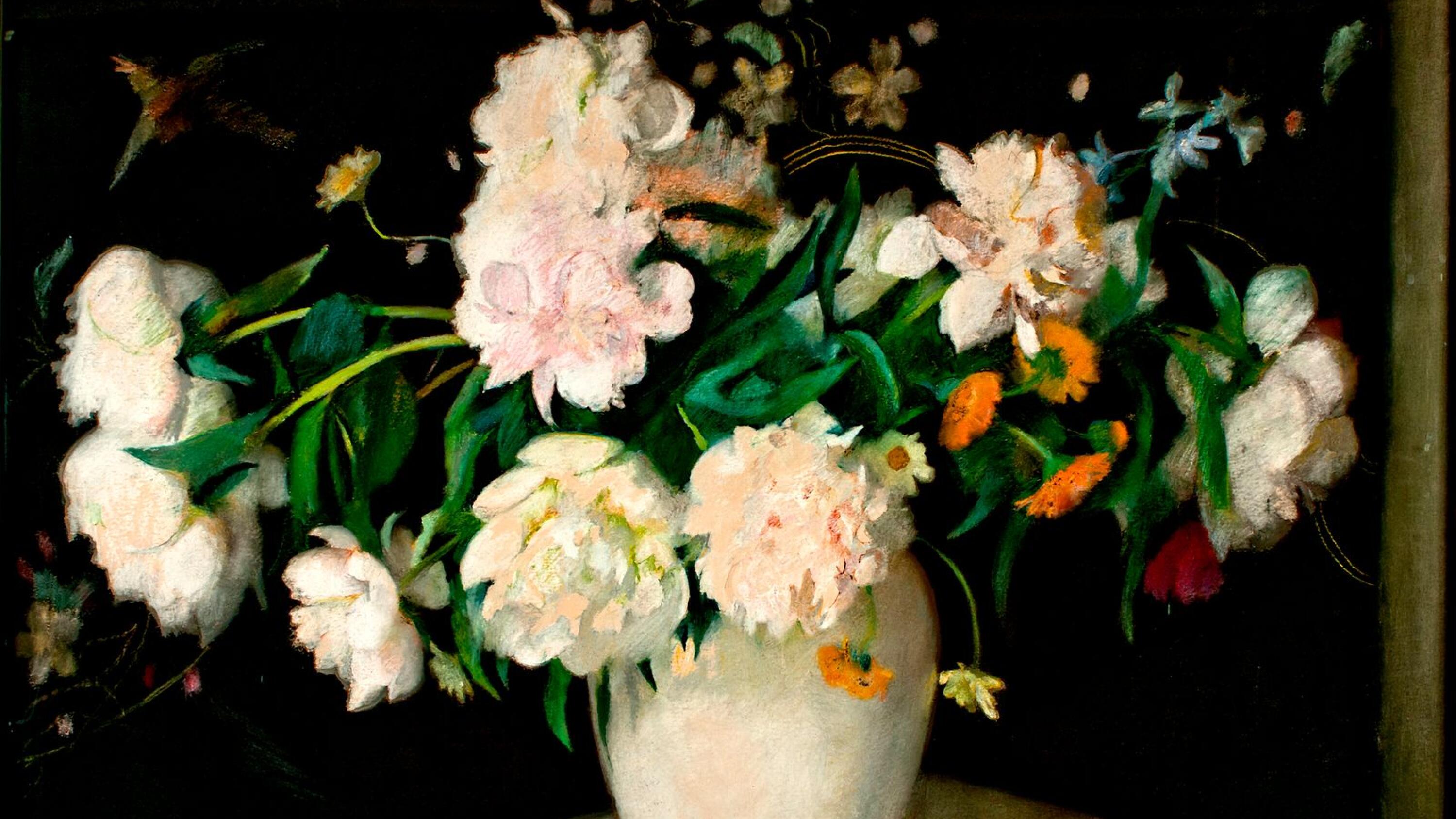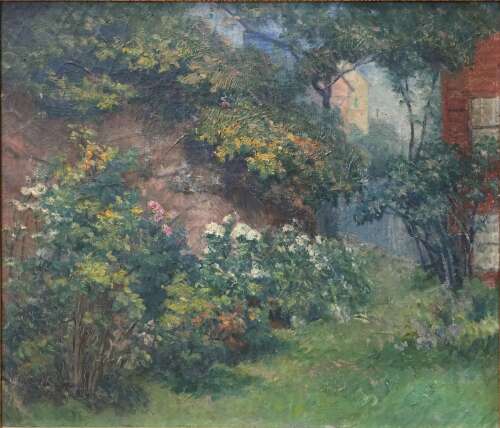Lorinda Dudley, “New London Road” (Submitted)
Agnes Harrison Lincoln, “Peonies” (Submitted)

Audrey Heard, “Pears” (Submitted)
Marjory Horn, “Red Lobster Shack” (Submitted)
Lorinda Dudley, “Mystic River with Pilings” (Submitted)
Over centuries, the artists who were featured in major exhibitions and books tended to be men. So were the people who created those exhibitions and wrote those books.
Consequently, women had to find their own way. As a new exhibition at the Mystic Museum of Art notes, “Historically discouraged from asserting themselves and their art, they had to rely on unconventional approaches to a career.”
The show titled “Women of Mystic” delves into the work and histories of some of the women who helped make the Mystic art colony what it was and what it became.
It also showcases a staggering range of art by these creators in terms of style and subject.
A woodblock print depicts a fanciful version of Noank. A landscape is marked with wisps of horizontal movement, suggesting the view from a rapidly moving train. A sculpture embodies a child’s cherubic face.
The exhibition also highlights some fascinating glimpses into their lives and their eras.
Lorinda Dudley (1845-1930) was one of the founding members of the Mystic Art Association, which later became the Mystic Museum of Art (MMoA). Her father was a blacksmith who did metalwork on Union ships built in Mystic during the Civil War. Hers was a prominent family, and she was able to study painting in Paris before returning to Connecticut to continue her artistic pursuits.
Minnie Negoro (1919-1998) was a 23-year-old UCLA student when she and her family were forced into an internment camp during World War II. It was there that she met Daniel Rhodes, whom the government assigned to establish a prison-labor factory that would produce ceramic tableware for the troops. The factory never came to be, but Rhodes taught Negoro at the camp. Afterward, he suggested she apply to the New York College of Ceramics at Alfred University, where he — and then she — studied.
Flora Fairchild (1923-2008), who was fluent in French and German, was recruited by the CIA after graduating from college in 1945. For two years, she worked in the covert section at the organization’s Washington, D.C.
Audrey Heard (1924-2012), a modern contemporary artist, also ran the Hands All Around fashion store in Mystic, where Meryl Streep bought the $60 pants she wore to the 1989 Oscars. Streep’s parents had a home on Masons Island. As MMoA assistant curator Amelia Onorato noted, Heard “obviously had a keen eye for colors and patterns, but she didn’t take an advanced art class until she was 67. She was a prolific painter for the rest of her life.”
“Women of Mystic” was curated by MMoA executive director and chief curator V. Susan Fisher, Onorato, and director of visitor services Cara Lopilato.
“We were very fortunate here that the permanent collection has a much higher ratio of female artists to male artists than is normal in a museum collection,” Onorato said. “But we didn’t want to pick pieces just for the tokenism of it. … We were very conscientious about choosing to focus on women artists who both had successful artistic careers themselves but also interesting personal lives outside of that — so women who had big accomplishments outside of just art.”
Fireworks and fine line work
Discussing some of their favorite pieces, Fisher mentioned Agnes Harrison Lincoln’s “Peonies.”
“It’s almost monochrome — it’s a dark background with white peonies. It sounds so conventional — ‘Oh, painting flowers’ — but these are fireworks of flowers. They’re so bold,” she said. “I just bathe in the view of that painting every day.”
Meanwhile, Onorato, who has a background in illustration and cartooning, said she adores very precise pen and ink work, which is why she’s drawn to Beatrice Edgerly Macpherson’s huge pen and ink drawing of a rooster, titled “October.”
“The benefit of working in black and white is that you can create that very sharp contrast that automatically draws your eye just because there is such a sharp difference between the white of the paper and the black of ink, but (you can see) just how precise her line work is,” she said. In other pen-and-ink creations, it’s clear artists have used gouache to fix some mistakes (“It was kind of like the Wite-Out of the time,” Onorato said). But “October” shows no trace of gouache.
All about pathways
Every year, MMoA chooses a curatorial theme and builds exhibitions around that. Fisher said, “Because it’s an election year, we wanted to talk about access and equity, and the theme is pathways because the conventional pathway to a career in the arts led through the academies of Europe. … For a great many artists, this was not just not accessible, it was not relevant. So the question for us this year is what can we learn from the unconventional pathways that artists have forged for themselves when they didn’t have access to that Grand Tour of Europe and access to the patronage of the elite? What examples can we show, what can we learn from them, and also how can we change that rule of thumb, that there is only one way generally?”
Women traditionally had a lack of access to a profession in the arts, but the curators found three pathways women could follow. One was being adjacent to an artist, whether that artist was, say, a family member or someone they were socially connected to.
“That is a remarkable story in itself because we’re talking about women who are literally adjacent to the arts but not trained in them,” Fisher said. “They pick up what they can through their own observation and their own motivation, which I have a lot of admiration for.”
The second pathway was through new social structures that emerged around the time of the Industrial Revolution. The start of art education in public schools was seen as a way, Fisher said, “to talent-spot for young artists and designers who could improve industrial manufactured items to compete with foreign goods.” Massachusetts was the first state, in 1821, to incorporate fine art into education as a way to develop talent for industry, she said.
The third pathway involved the Works Progress Administration’s Federal Art Project during the late 1930s and early ‘40s.
“One of the things that was so visionary about the WPA and the Federal Art Project in particular is that (President Franklin D.) Roosevelt made no distinction between men and women artists. … Neither did he make any distinction between representational and abstract work. Many people do not appreciate the fact that he favored Jackson Pollock’s work as much as Thomas Hart Benton’s work, for example,” Fisher said.
Beatrice Cuming (1903-1975) was a female WPA artist, a really revolutionary figure — a woman interested in industrial subject matter, Fisher said. Cuming, who resided in New London for a good deal of her life, painted subjects like smokestacks in Montville and submarines in Groton.
Fisher added that history has not treated Cuming as kindly as her male contemporaries like Charles Sheeler.
“Of course, histories of art are written largely by men and tell the stories of men, whereas someone like Beatrice, in my view, could absolutely hold her own,” Fisher said.
Onorato noted that some women came into art training much later in life. They had owned stores or worked in other industries, and it wasn’t until their 40s or 50s or 60s that they took art classes, often with other artists featured in the “Women of Mystic” exhibition.
For instance, Katherine Tod Johnstone (1922-1999) did oil paintings but in her 40s took her first sculptural class with Lyme Academy of Fine Arts founder Elisabeth Gordon Chandler. She found she loved creating sculptures of animals and went on to take classes with Beonne Boronda, who was also very interested in sculpting animals and whose influence can be seen in Johnstone’s work.
Earlier, during her own studies, Boronda (1911-2012) took a life drawing class where the artists worked from the same angle for a month. Boronda asked to change positions so she could get different angles. As the exhibition cheekily notes, “This prepared her to work with her favorite subjects, animals, who do not pose.”
Fisher said, “The intentional community of an art colony gave women not just permission but gave them prestige. The artists that they knew and worked with were just as willing to respect them and promote them as they were willing to respect and promote male artists.”
Inspiring the next generation
Fisher said that she hopes the “Women of Mystic” exhibition will “not just celebrate women as artists … but that we will build an awareness that will affect young girls growing up who can … look on the wall of a museum and say, ‘That’s me, I could do that.’”
Fisher and Onorato mentioned the notes that visitors have left in the gallery guestbook, including these:
“Beautiful exhibits and graceful experience for our daughters to see Women of Mystic and chairs exhibits. Thank you!”
— The Alexanders, NYC
“As a women’s rights activist and art lover, I really appreciate the ‘Women of Mystic’ exhibition! Thank you and all the best from Belgium.”
— Laura Kaun
“One of my favorite exhibitions here – among many! Great job, everyone… Love the history and legacy of Mystic’s women artists.”
— Luanne Rice
If you go
What: “Women of Mystic”
Where: Mystic Museum of Art, 9 Water St., Mystic
When: MMoA reopens May 4, and the exhibition runs through June 2
Hours: 11 a.m.-5 p.m. daily
Admission: Free, donations accepted
Contact: (860) 536-7601, mysticmuseumofart.org

